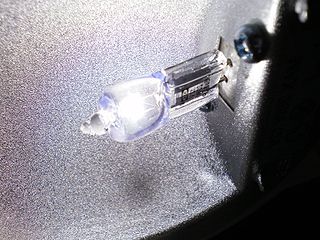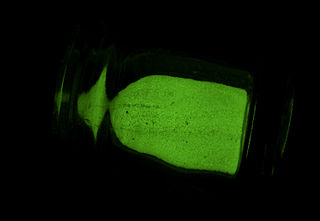
An electric light is a device that produces visible light from electric current. It is the most common form of artificial lighting and is essential to modern society, providing interior lighting for buildings and exterior light for evening and nighttime activities. In technical usage, a replaceable component that produces light from electricity is called a lamp. Lamps are commonly called light bulbs; for example, the incandescent light bulb. Lamps usually have a base made of ceramic, metal, glass or plastic, which secures the lamp in the socket of a light fixture. The electrical connection to the socket may be made with a screw-thread base, two metal pins, two metal caps or a bayonet cap.

An incandescent light bulb, incandescent lamp or incandescent light globe is an electric light with a wire filament heated to such a high temperature that it glows with visible light (incandescence). The filament is protected from oxidation with a glass or fused quartz bulb that is filled with inert gas or a vacuum. In a halogen lamp, filament evaporation is slowed by a chemical process that redeposits metal vapor onto the filament, thereby extending its life.

A halogen lamp, also known as a tungsten halogen, quartz-halogen or quartz iodine lamp, is an incandescent lamp consisting of a tungsten filament sealed into a compact transparent envelope that is filled with a mixture of an inert gas and a small amount of a halogen such as iodine or bromine. The combination of the halogen gas and the tungsten filament produces a halogen cycle chemical reaction which redeposits evaporated tungsten to the filament, increasing its life and maintaining the clarity of the envelope. For this to happen, a halogen lamp must be operated at a higher envelope temperature than a standard vacuum incandescent lamp of similar power and operating life; this also produces light with higher luminous efficacy and color temperature. The small size of halogen lamps permits their use in compact optical systems for projectors and illumination. The small glass envelope may be enclosed in a much larger outer glass bulb for a bigger package; the outer jacket will be at a much lower and safer temperature, and it also protects the hot bulb from harmful contamination and makes the bulb mechanically more similar to a conventional lamp that it might replace.

A flashlight is a portable hand-held electric light. The source of the light is usually an incandescent light bulb (lamp) or light-emitting diode (LED). A typical flashlight consists of the light source mounted in a reflector, a transparent cover to protect the light source and reflector, a battery, and a switch. These are supported and protected by a case.

High-intensity discharge lamps are a type of electrical gas-discharge lamp which produces light by means of an electric arc between tungsten electrodes housed inside a translucent or transparent fused quartz or fused alumina arc tube. This tube is filled with noble gas and often also contains suitable metal or metal salts. The noble gas enables the arc's initial strike. Once the arc is started, it heats and evaporates the metallic admixture. Its presence in the arc plasma greatly increases the intensity of visible light produced by the arc for a given power input, as the metals have many emission spectral lines in the visible part of the spectrum. High-intensity discharge lamps are a type of arc lamp.

Bicycle lighting is illumination attached to bicycles whose purpose above all is, along with reflectors, to improve the visibility of the bicycle and its rider to other road users under circumstances of poor ambient illumination. A secondary purpose is to illuminate reflective materials such as cat's eyes and traffic signs. A third purpose may be to illuminate the roadway so that the rider can see the way ahead. Serving the latter purposes require much more luminous flux and thus more power.

A metal-halide lamp is an electrical lamp that produces light by an electric arc through a gaseous mixture of vaporized mercury and metal halides. It is a type of high-intensity discharge (HID) gas discharge lamp. Developed in the 1960s, they are similar to mercury vapor lamps, but contain additional metal halide compounds in the quartz arc tube, which improve the efficiency and color rendition of the light. The most common metal halide compound used is sodium iodide. Once the arc tube reaches its running temperature, the sodium dissociates from the iodine, adding orange and reds to the lamp's spectrum from the sodium D line as the metal ionizes. As a result, metal-halide lamps have high luminous efficacy of around 75–100 lumens per watt, which is about twice that of mercury vapor lights and 3 to 5 times that of incandescent lights and produce an intense white light. Lamp life is 6,000 to 15,000 hours. As one of the most efficient sources of high CRI white light, metal halides as of 2005 were the fastest growing segment of the lighting industry. They are used for wide area overhead lighting of commercial, industrial, and public spaces, such as parking lots, sports arenas, factories, and retail stores, as well as residential security lighting and automotive headlamps.

A daytime running lamp is an automotive lighting and bicycle lighting device on the front of a roadgoing motor vehicle or bicycle, automatically switched on when the vehicle is in drive, emitting white, yellow, or amber light. Their job isn't to help the driver see the road but to help other road users see the vehicle.

The lighting system of a motor vehicle consists of lighting and signalling devices mounted or integrated to the front, rear, sides, and in some cases the top of a motor vehicle. This lights the roadway for the driver and increases the visibility of the vehicle, allowing other drivers and pedestrians to see a vehicle's presence, position, size, direction of travel, and the driver's intentions regarding direction and speed of travel. Emergency vehicles usually carry distinctive lighting equipment to warn drivers and indicate priority of movement in traffic.
Federal Motor Vehicle Safety Standard 108 regulates all automotive lighting, signalling and reflective devices in the United States. Like all other Federal Motor Vehicle Safety Standards, FMVSS 108 is administered by the United States Department of Transportation's National Highway Traffic Safety Administration.

The World Forum for Harmonization of Vehicle Regulations is a working party (WP.29) of the Sustainable Transport Division of the United Nations Economic Commission for Europe (UNECE). It is tasked with creating a uniform system of regulations, called UN Regulations, for vehicle design to facilitate international trade.

Selective yellow is a colour for automotive lamps, particularly headlamps and other road-illumination lamps such as fog lamps. Under ECE regulations, headlamps were formerly permitted to be either white or selective yellow—in France, selective yellow was mandatory for all vehicles' road-illumination lamps until 1993.

A parabolic aluminized reflector lamp is a type of electric lamp that is widely used in commercial, residential, and transportation illumination. It produces a highly directional beam. Usage includes theatrical Lighting, locomotive headlamps, aircraft landing lights, and residential and commercial recessed lights.

Stage lighting instruments are used in stage lighting to illuminate theatrical productions, concerts, and other performances taking place in live performance venues. They are also used to light television studios and sound stages.

The Electronic Theatre Controls (ETC) Source Four is an ellipsoidal reflector spotlight (ERS) used in stage lighting. First released in 1992, the Source Four was invented by David Cunningham and features an improved lamp and reflector compared to previous ERS designs, tool-free lamp adjustment, and a rotating, interchangeable shutter barrel. The Source Four is widely used by professional theaters across the globe.

A multifaceted reflector light bulb is a reflector housing format for halogen as well as some LED and fluorescent lamps. MR lamps were originally designed for use in slide projectors, but see use in residential lighting and retail lighting as well. They are suited to applications that require directional lighting such as track lighting, recessed ceiling lights, desk lamps, pendant fixtures, landscape lighting, retail display lighting, and bicycle headlights. MR lamps are designated by symbols such as MR16 where the diameter is represented by numerals indicating units of eighths of an inch. Common sizes for general lighting are MR16 and MR11, with MR20 and MR8 used in specialty applications. Many run on low voltage rather than mains voltage alternating current so requiring a power supply.
The H1 is a halogen lamp designed for use in automotive headlamps and fog and driving lamps. It has also been widely applied in emergency vehicle lights.
Havells Sylvania and formerly SLI, is an international designer and manufacturer of lighting products, trading as Sylvania. It has plants throughout Europe, Asia, North Africa and Central and South America, and is one of the few lighting companies that produces both lamps and lighting fixtures. It is owned by Shanghai Feilo Acoustics Ltd., having previously been owned by the Indian electrical company Havells.

Halo headlights are automotive front lighting units with luminous rings inside the headlight assembly. Introduced in 2000 by BMW, halos were originally typical of this automaker's cars but soon became a popular customization option to enhance any vehicle's front end appearance.


















